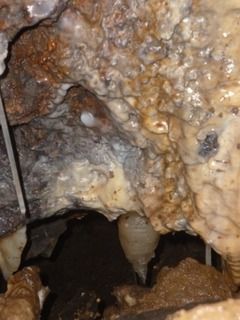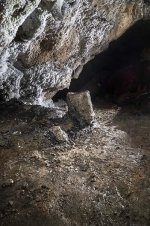Kenilworth
New member
Often cave diggers and explorers have to decide whether or not to break formations to make a way onward. This has been discussed many times on this forum, and everyone will have a different point of balance beyond which they would be uncomfortable. Before making the final decision, it is good to exhaust other options: looking into the lead by extending a camera, searching for alternate routes, making an informed assessment of the geological potential beyond (get help with this if you need it) etc.
One thing I haven't seen discussed here is the removal of speleothems with a view to putting them back later. If speleothems are a resource (and if we work to replace other resources we use, trees by foresters, for example) then why not learn to damage them without causing complete ruin?
I have come behind after a group of mappers had made the hard decision to remove some attractive formations. Their choice paid off in the discovery of a fair amount of stunning passage, but I was sorry to see large and small stalactites mixed with the rest of the dig spoils and shoved into a crack. Clearly, though much serious thought had been given to the quandary of removing them or not, no thought at all had been given to the possibility of repair.
An intention to put formations back will require us to think carefully about how we remove them, and about how and where they will be stored and organized. I have never seen much information about such things, and some trial and error will probably be involved. And we will necessarily need to know how to put them back when or if the time comes to do so. This knowledge is relatively commonplace, and easily found on this forum. If we do remove then replace formations, it would be helpful to document this action in any publicized maps or descriptions so that future visitors are aware that the lead beyond has been exhausted. This may require some careful wording if we are worried about landowner or judicial penalty.
Communication between cavers and cave scientists may also, rarely, help avoid unneeded removal, as scientists in need of specimens could make efforts to obtain them from dig sites.
One thing I haven't seen discussed here is the removal of speleothems with a view to putting them back later. If speleothems are a resource (and if we work to replace other resources we use, trees by foresters, for example) then why not learn to damage them without causing complete ruin?
I have come behind after a group of mappers had made the hard decision to remove some attractive formations. Their choice paid off in the discovery of a fair amount of stunning passage, but I was sorry to see large and small stalactites mixed with the rest of the dig spoils and shoved into a crack. Clearly, though much serious thought had been given to the quandary of removing them or not, no thought at all had been given to the possibility of repair.
An intention to put formations back will require us to think carefully about how we remove them, and about how and where they will be stored and organized. I have never seen much information about such things, and some trial and error will probably be involved. And we will necessarily need to know how to put them back when or if the time comes to do so. This knowledge is relatively commonplace, and easily found on this forum. If we do remove then replace formations, it would be helpful to document this action in any publicized maps or descriptions so that future visitors are aware that the lead beyond has been exhausted. This may require some careful wording if we are worried about landowner or judicial penalty.
Communication between cavers and cave scientists may also, rarely, help avoid unneeded removal, as scientists in need of specimens could make efforts to obtain them from dig sites.







